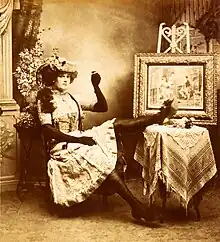| Paresis Hall | |
|---|---|
| Alternative names | Columbia Hall |
| General information | |
| Address | 392 Bowery (now 32 Cooper Square) |
| Town or city | New York City |
| Country | United States |
| Coordinates | 40°43′41″N 73°59′29″W / 40.728183°N 73.991400°W |
| Owner | James T. Ellison |
Columbia Hall, commonly known as Paresis Hall, was a brothel and gay bar located in the Bowery, in New York City, in the 1890s.[1] Located on the Bowery near Cooper Union, the Hall was owned by the gangster James T. Ellison.[1]
Name
Paresis Hall took its common nickname from general paresis, a term for syphilitic insanity.[2]
Jennie June wrote that the name "Paresis Hall" was the popular name, but androgynes disliked that name, and instead referred to it as "the Hall".[3] June wrote that the term paresis was used as a general term for insanity, but also wrote that the name followed a superstition that androgynes could cause virile men to succumb to insanity, later discovered to be a side effect of advanced syphilis.[3]
Floors
On the ground floor, Paresis Hall had a small bar room in front, and a small beer garden behind it.[3] The two floors above the ground floor were rented out in small rooms.[3] At least ten rooms above the bar were used for private encounters.[1]
Cercle Hermaphroditos
One space above the bar was permanently rented by the Cercle Hermaphroditos, an early transgender advocacy organization. They stored clothing there due to the illegality of and public hostility to dressing in women's clothing.[4]
According to historian Susan Stryker, the Cercle Hermaphroditos was the first group in the United States to be concerned with what today would be considered transgender social justice issues.[5]
Opposition
Paresis Hall was particularly renowned and reviled even at the time, and was a common target for both police activity and religious protests.[6] Despite this, evidence suggests it was active until at least 1899.[1]
See also
References
- 1 2 3 4 Ditmore, Melissa Hope (2006). Encyclopedia of Prostitution and Sex Work. Vol. 2. Westport, Connecticut: Greenwood Press. pp. 343–344. ISBN 978-0313329708.
- ↑ Long 2009, p. 23.
- 1 2 3 4 June, Jennie (1922). The Female-Impersonators. New York City: The Medico-Legal Journal. pp. 146–151.
- ↑ Chauncey 2008, p. 43.
- ↑ Stryker, Susan (2017). Transgender History (2nd ed.). Berkeley: Seal Press. pp. 57–58. ISBN 978-1580056892.
- ↑ Hatheway 2005, p. 55.
Bibliography
- Chauncey, George (2008). Gay New York: Gender, Urban Culture, and the Making of the Gay Male World, 1890–1940. Basic Books. ISBN 9780786723355.
- Ditmore, Melissa (2006). Encyclopedia of prostitution and sex work. Westport, Conn.: Greenwood Press. ISBN 0313329680.
- Hatheway, Jay (2005). The Gilded Age Construction of Modern American Homophobia (1st ed.). New York: Palgrave Macmillan. ISBN 1403974004.
- Long, Kat (2009). The forbidden apple : a century of sex & sin in New York City. Brooklyn, N.Y.: Ig Pub. ISBN 978-0981504001.
